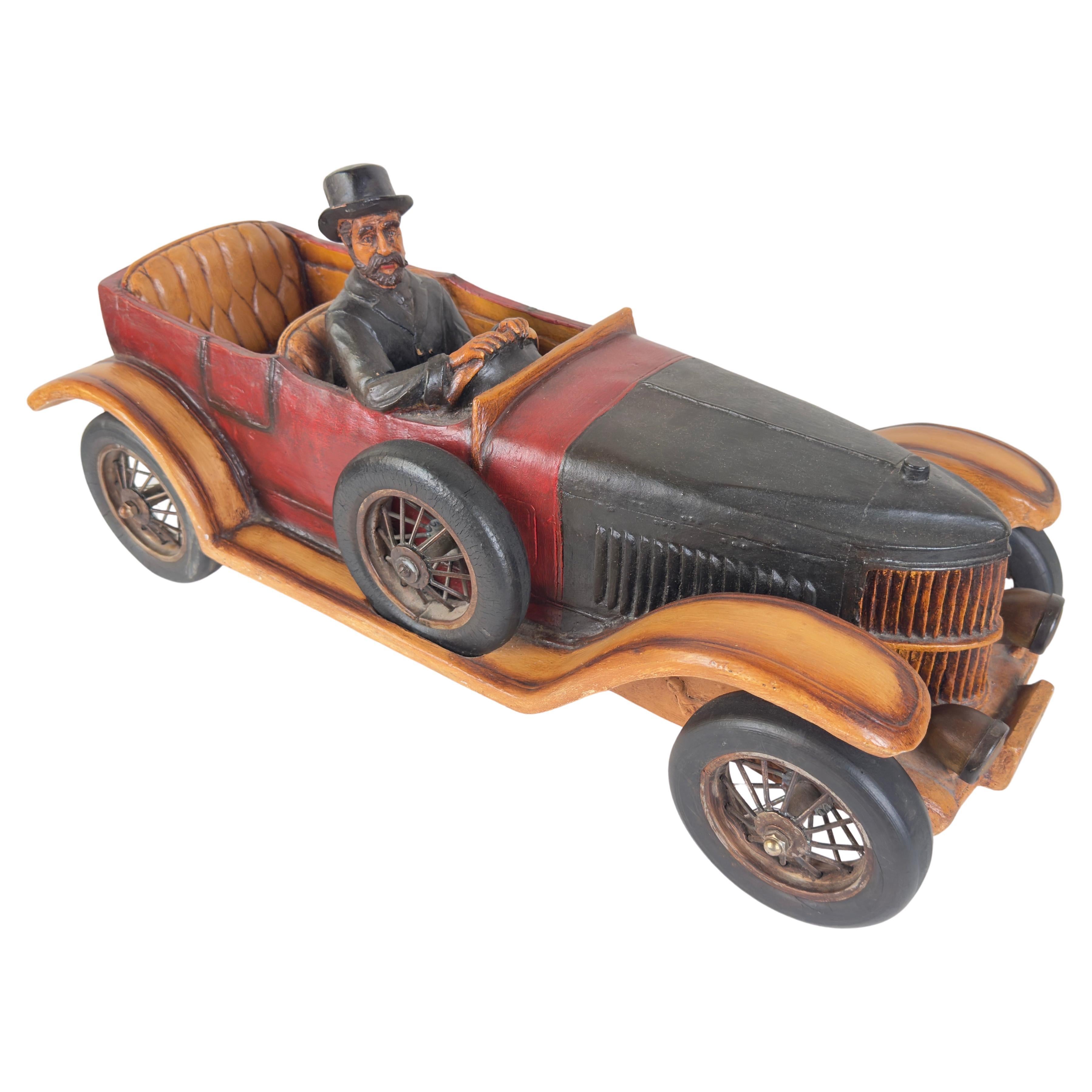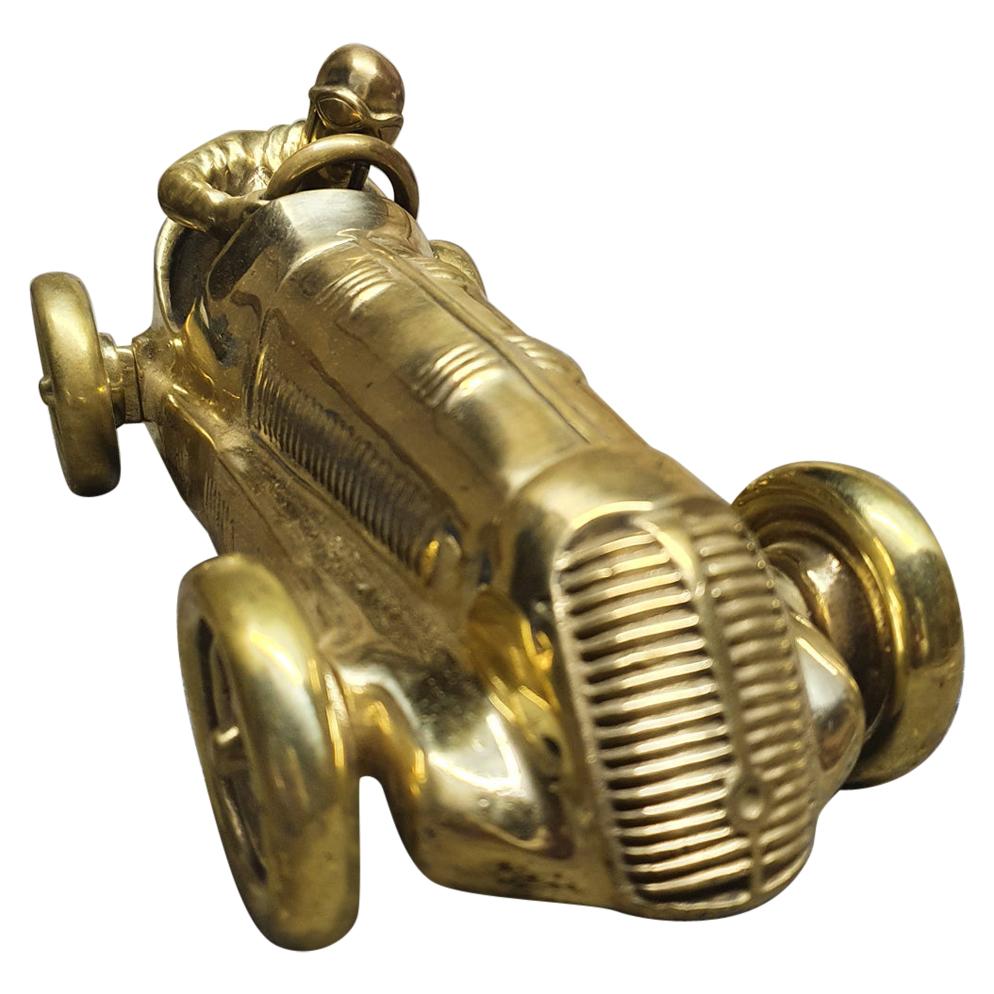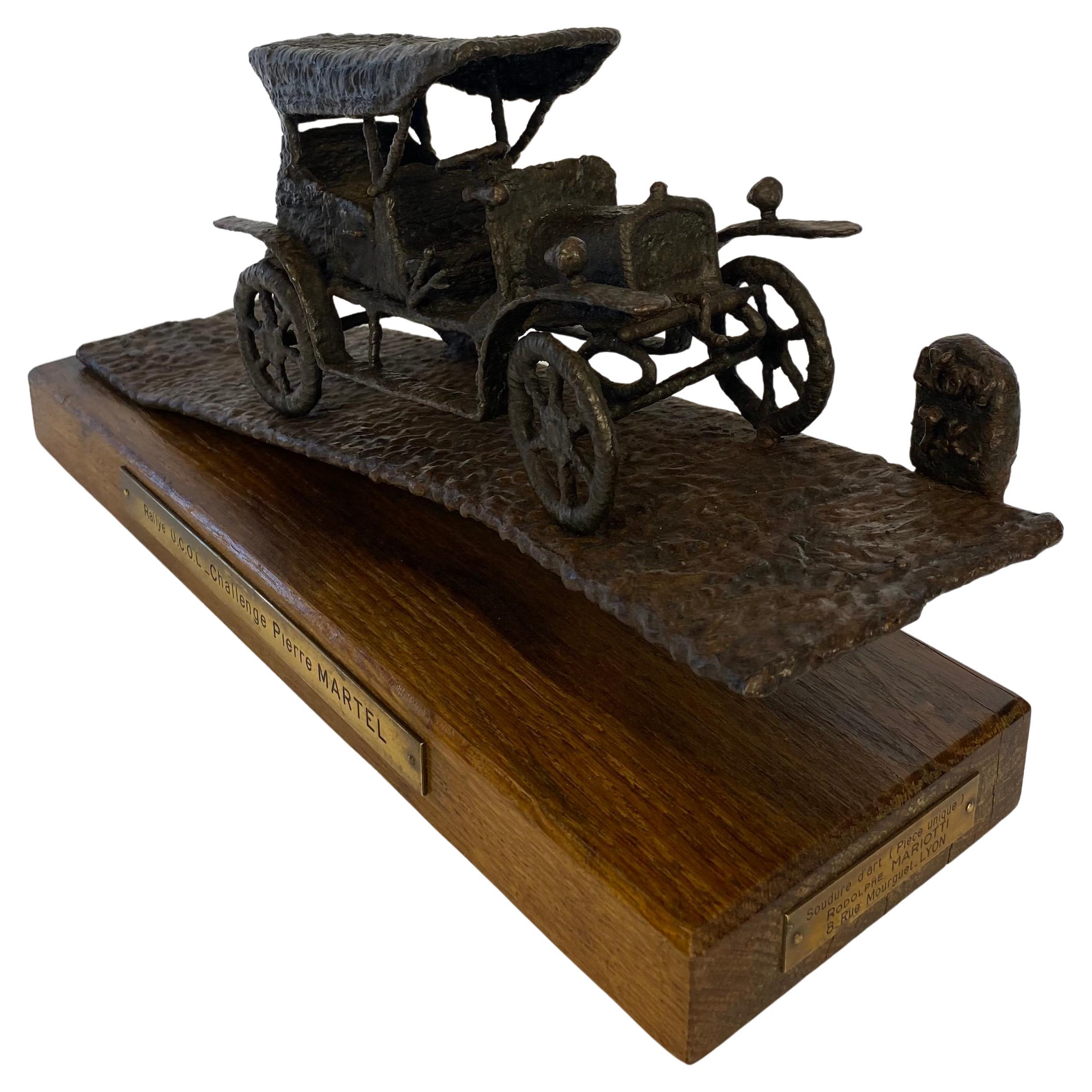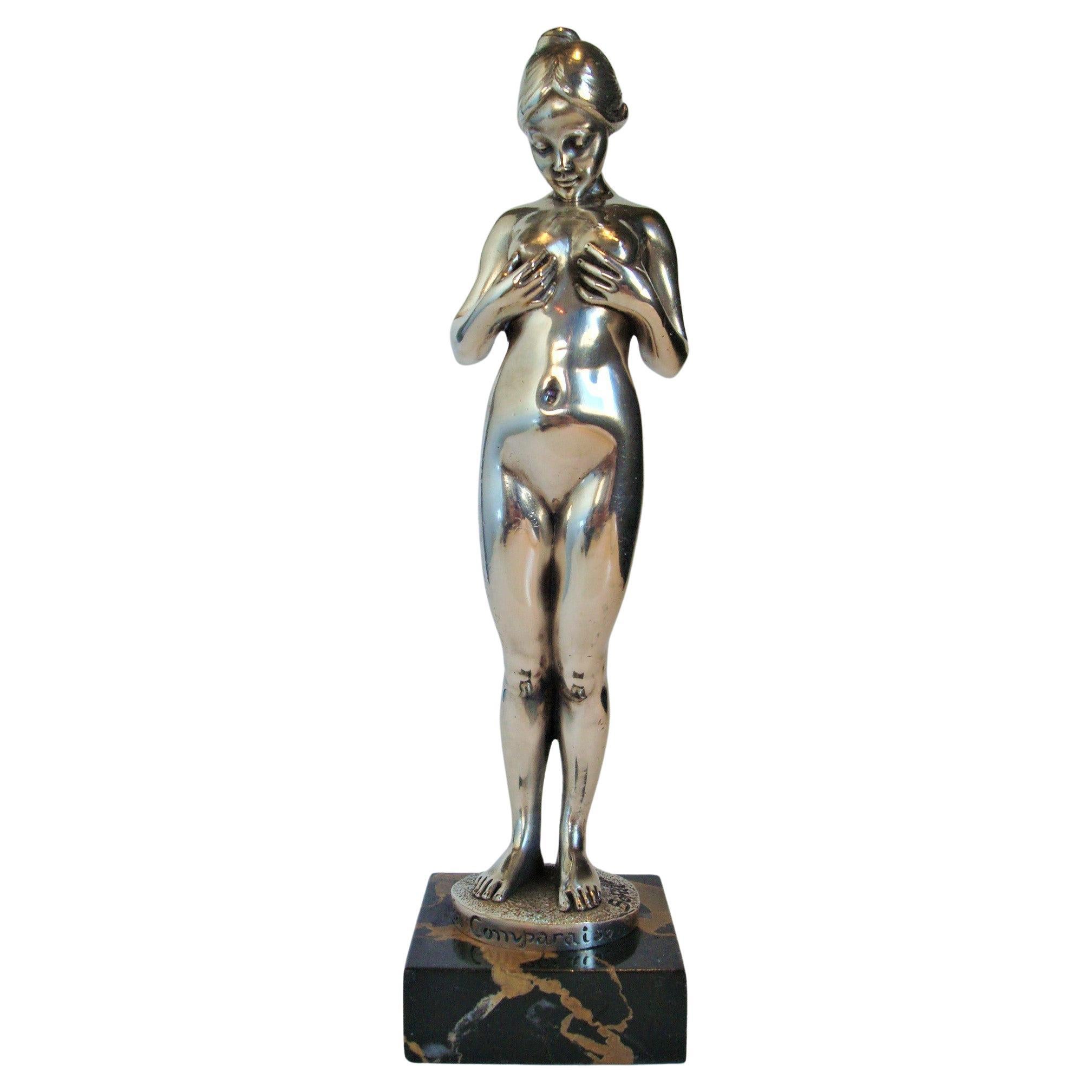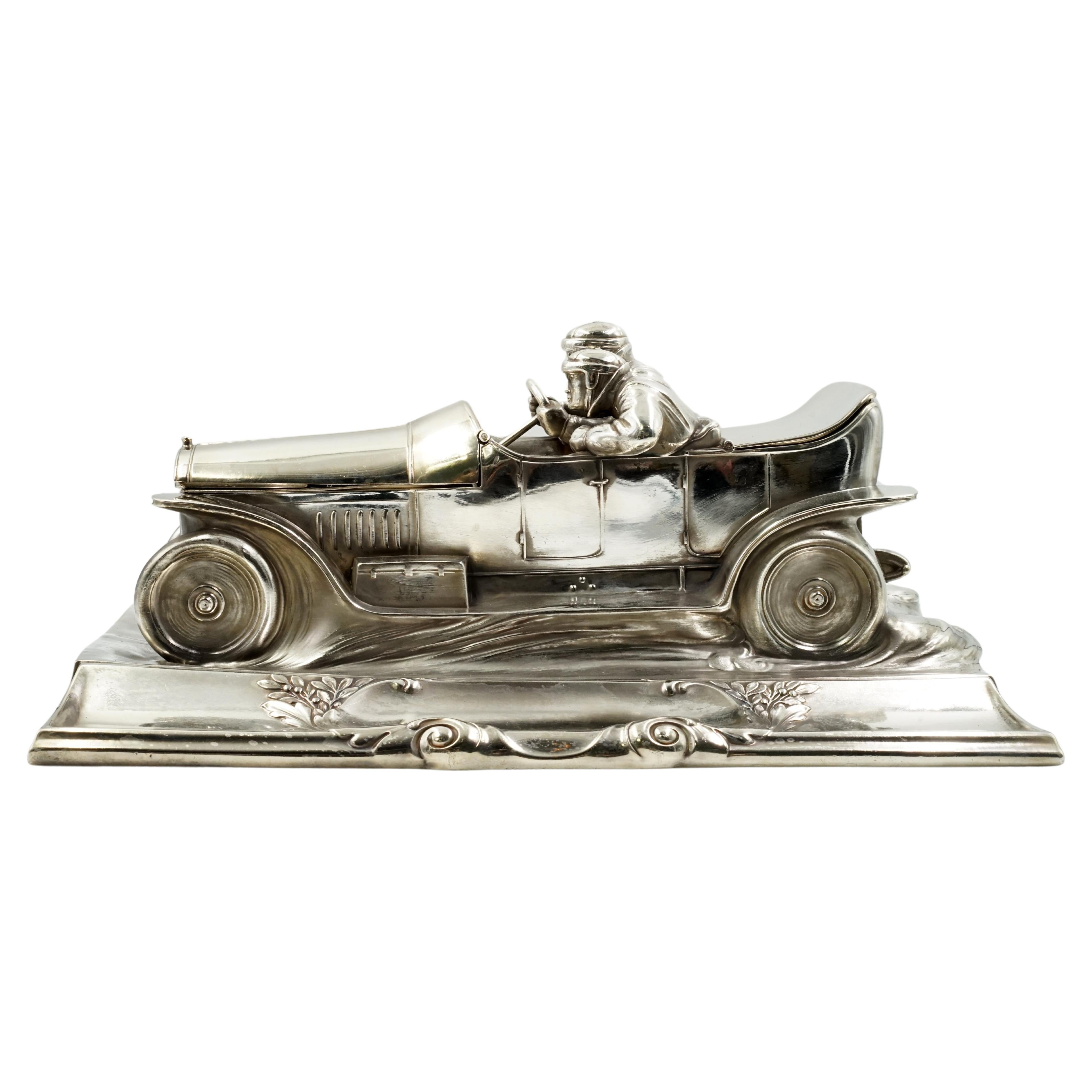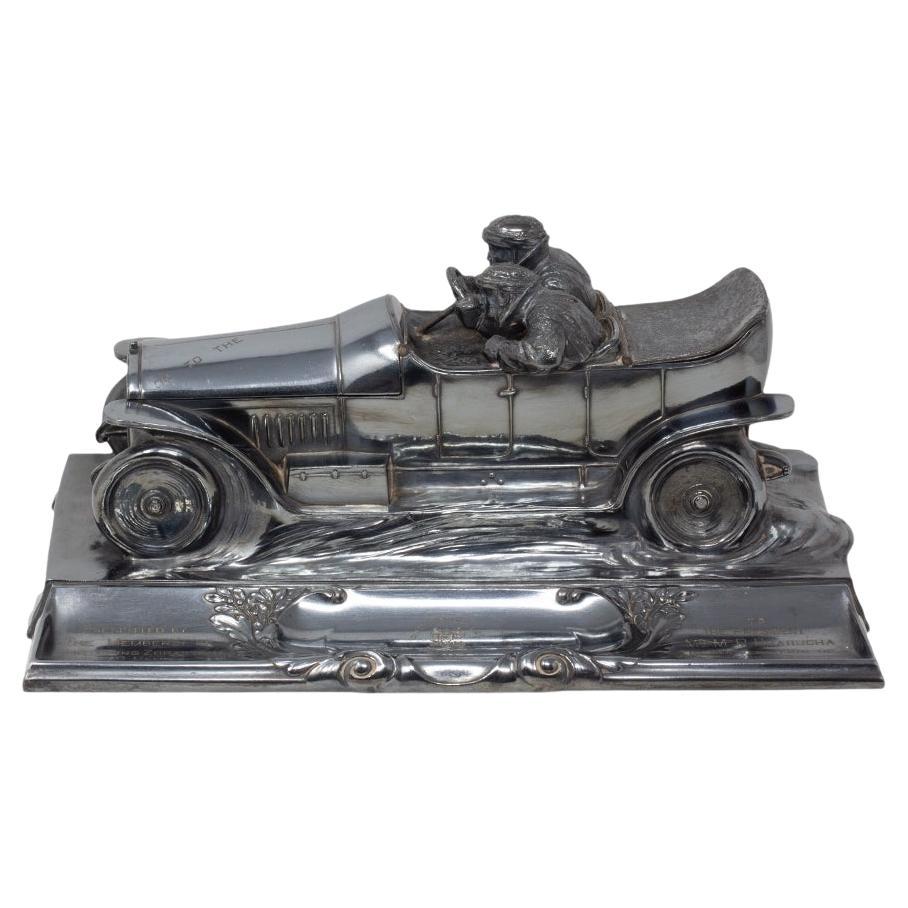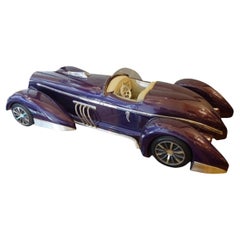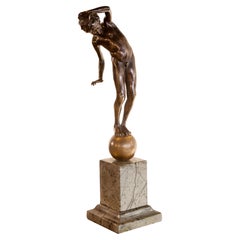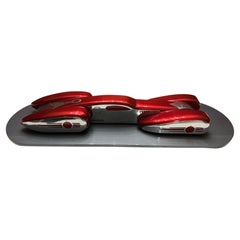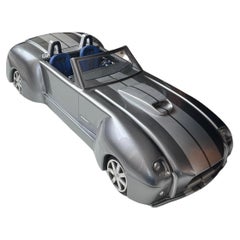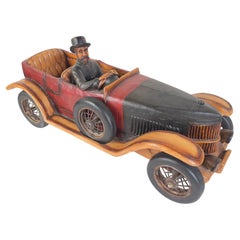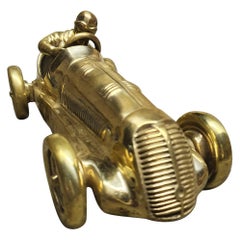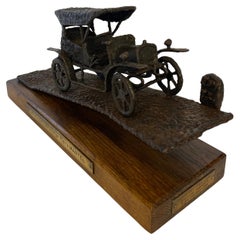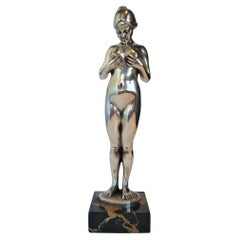Items Similar to Medida :1920, Car Sculpture in wood Sign: Argentor wien
Video Loading
Want more images or videos?
Request additional images or videos from the seller
1 of 18
Medida :1920, Car Sculpture in wood Sign: Argentor wien
$32,000
£24,465.70
€28,179.55
CA$44,841.81
A$50,061.67
CHF 26,231.56
MX$612,803.92
NOK 333,141.07
SEK 314,109.73
DKK 210,306.86
Shipping
Retrieving quote...The 1stDibs Promise:
Authenticity Guarantee,
Money-Back Guarantee,
24-Hour Cancellation
About the Item
Material: Wood and silver plated bronze
We have specialized in the sale of Art Deco and Art Nouveau and Vintage styles since 1982. If you have any questions we are at your disposal.
Pushing the button that reads 'View All From Seller'. And you can see more objects to the style for sale.
Argentor wien (Austria)
he history of the company dates back to 1863, when CA Münchmeyer & Co. was founded. This was the owner of an electroplating factory that was built in 1894 on a narrow, long stretch of land between Kaiserstraße and Wimbergergasse in the 7th district of Vienna . CA Münchmeyer & Co. had Stagl Brodhag build a residential and administrative building at Kaiserstrasse 83, along with a six-storey courtyard wing. Branch factories existed in Berlin and Paris in the early 20th century, with branches in Vienna at Casa Piccola at Mariahilfer Strasse 1c in the 6th district and at Waitznergasse 14 in the 4th district of Budapest.
In 1902, the predecessor company CA Münchmeyer & Co. became the Argentor-Werke Rust & Hetzel. Over time, the Argentor-Werke became one of the most important metalware manufacturers of Viennese Art Nouveau . Not only silver cutlery , bowls , centerpieces, tea and coffee services were manufactured , but also home furnishings such as frames , clocks , electric lamps , vases and flower holders. Of particular importance were the so-called mount articles, which were mounted glasses with the frame manufactured by the Argentor works. A number of the glasses used came from the famous Art Nouveau glass company Joh. Loetz Witwe , with whom Argentor worked.
The company became very successful, producing thousands of models and exporting worldwide. A company publication from 1912 mentions about 9000 articles of goods. In 1911 there were branches in Budapest and Brno . [3] Customers included not only the upper classes and the aristocracy, but also the imperial court. For their merits, the owners Georg Ferdinand Rust and Adolf Wilhelm Hetzel were awarded the title of kuk purveyor to the court . [4]
Despite all the turmoil, the Argentor-Werke survived the First World War , but with increasing financial losses. It produced some movements during World War II , but ceased to exist at the latest in 1970. Exquisite works from the Argentor factories fetch high prices at auction today.
Why are there so many antiques in Argentina?
In the 1880 – 1940 there was a grate wave of immigration encouraged by the periods of war that were taking place.
1st World War took place between 1914 and 1918
2nd World War took place between 1939 and 1945
The immigrants options were New York or Buenos Aires. Tickets were cheap and in Buenos Aires they were welcomed with open arms, as it was a country where everything was still to be done.
Argentina was the country of new opportunities, labour was needed and religious freedom was assured, in many cases the of the family travel first until they were settled and then the rest of the family members join them.
In the immigrant museum “Ellis Island Immigrant Building” in New York you can se the promotional posters of the boats that would take them to a new life.
Between the years 1895 and 1896, Argentina had the highest DGP (gross domestic product) per capita in the world according to the Maddison Historical Statistics index, this situation arose due to the large amount of food being exported to European countries, which were at war.
The Argentinean ships left the port of Buenos Aires with food, but they returned with furniture, clothes and construction elements, (it´s common to see this the old buildings of the historic neighbourhood of San Telmo, the beams with the inscription “Made in England)”, as well as many markets that were built in Buenos Aires, such us the San Telmo Market, whose structure was brought by ship and afterwards assembled in 900 Defensa Street.
With the great influence of European immigrants living in the country, the children of the upper classes travelled to study in France, resulting in the inauguration of “La Maison Argentinienne”, on 27th of June 1928, in the international city of Paris, which hosted many Argentinians that were studying in Frace.
It´s the fourth house to be built after France, Canada and Belgium, being the first Spanish-speaking one. Still in place today (17 Bd Jourdan, 75014, Paris, France). Many of the children of these wealthy families who attended international art exhibitions, museums and art courses abroad, took a keen interest in the European style. This is why Buenos Aires was at the time referred as “The Paris of South America”.
Between the years 1890 and 1920 more than a hundred Palaces were built on Alvear Avenue the most exclusive avenue in Buenos Aires. Today some of these palaces have been transformed into museums, hotels and embassies.
In the year 1936, the Kavanagh building was inaugurated, it was the tallest reinforced concrete building in South America.
During 1994 the American Society of Civil Engineers distinguished it as an “international engineering milestone”, and it´s now considered a World Heritage of Modern Architecture.
At the time was common to hire foreign architects such as Le Corbusier, who visited Buenos Aires/Argentina in 1929 and in 1948 he drew up the blueprints for a house built in La Plata City (which was declared a World Heritage Site).
In 1947, the Hungarian architect Marcelo Breuer designed “Parador Ariston” in the seaside city of Mar del Plata. After an Argentinean student at Harvard University convinced him to come to Argentina. He worked on an urban development project in the Casa Amarilla, area of La Boca.
The Ukrainian architect, Vladimiro Acosta, arrives in Argentina in 1928 and worked as an architect until que moved to Brazil.
Antonio Bonet, a Spanish architect who worked with Le Corbusier in Paris, arrives in Argentina in 1937, where he carried out several architectural works and in 1938 designs the well-known BFK chair.
Andres Kálnay, of Hungarian origin, made around 120 architectural masterpieces, among which the former Munich brewery stands out, he even made the furniture’s design.
The German architect, Walter Gropius, director of the Bauhaus, lived in Argentina, where he wrote articles for “Sur” magazine and founded in Buenos Aires, an architectural firm with Franz Möller, who was also an architect, where he built two houses.
At the same time several famous designers decided to immigrate to Argentina, among them we can find the well-known French designer, Jean-Michel Frank, who arrived in the country in 1940 and also worked for the Rockefeller family.
Special pieces were made, which were sold exclusively in the country, such as the well-known German company “WMF”, who sold their products by catalogue, which were chosen by the ladies of high society in the list of wedding gifts, as well as the pieces designed by Christofle.
The Swiss sculptor Alberto Giacometti, made special pieces for Argentinean mansions.
In 1904 the first Jansen branch outside Paris was established in Buenos Aires, as the Argentinean clientele demanded a large amount of furniture, from the end of the 19th century to the mid-20th century.
In 1970, the brand Rigolleau Argentina made pieces authorised by Lalique.
The brands Maple and Thompson also set up shop in the country.
The French plastic artist, Marcel Duchamp moved to Argentina in 1918-1919.
Glass signed Gallé, Charder, Leverre, Schneider, Muller and other French firms. They were bought in flower shops and were given to ladies with beautiful floral arrangements.
Some furniture manufacturers travelled to international fairs and bough the patterns to produce the furniture in Argentina, such as the furniture firm Englander and Bonta, who bought the patterns ins Italy.
It is worth mentioning that in Argentina we have the largest community of Italians outside of Italy, as it is estimated that 70 percent of the inhabitants have at least one Italian descendant, followed by Spanish immigrants.
The most Important furniture stores in Argentina:
Comte is founded in 1934 (under the direct management of Jean Michel Frank in 1940).
Nordiska (Swedish company established in 1934).
Churba in 1960, a company that brought foreign designers to present their furniture in the country:
Denmark: (Arne Jacobsen, Finn Juhl, Bender Madsen, Ejner Larsen, Poul Kjaerholm, Hans Wegner)
Sweden: (Hans Agne Jakobsson, Gustavsberg)
United States: (Herman Miller)
Finland: (Lisa Johansson, Folke Arstrom, Tapio Wirkkala, Alvar Aalto, Timo Sarpaneva)
Swedish Factory: (Orrefors)
Italy: (Littala, Vico Magistretti, Emma Gismondi, Gae Aulenti, Angelo Mangiarotti, Elio Martinelli, Gianna Celada, Angelo Mangiarotti, Mario Bellini, Carlo Scarpa)
Finland: (Olivia Toikka)
Plata Lappas (Lappas Silver): a goldsmith shop founded in 1887 in Argentina by Alcibiades Lappas of Greek origin.
In 2019, in Argentina took place “the Art Deco world congress”, in which we participated as hosts invited by Geo Darder, founder of the Copperbridge – Foundation, in which prominent people from all over the world attended to learn about Art Deco in Argentina.
Argentina currently has more than 100 Art Deco buildings and another 90 Art Nouveau buildings throughout the city of Buenos Aires.
Argentina is a country that has not been involved in many wars, which is why it has been a refuge for works of art and antiques from different periods of time, unlike European countries. That is way many collectors, museums and antique dealers from all over the world visit it, you should not miss the opportunity to visit this great country.
Laura Guevara Kjuder, architect.
- Creator:Argentor of Vienna (Manufacturer)
- Dimensions:Height: 15.36 in (39 cm)Width: 27.56 in (70 cm)Depth: 12.6 in (32 cm)
- Style:Art Deco (Of the Period)
- Materials and Techniques:
- Place of Origin:
- Period:
- Date of Manufacture:1920
- Condition:Wear consistent with age and use.
- Seller Location:Ciudad Autónoma Buenos Aires, AR
- Reference Number:1stDibs: LU6785230957112
About the Seller
5.0
Vetted Professional Seller
Every seller passes strict standards for authenticity and reliability
Established in 1982
1stDibs seller since 2022
37 sales on 1stDibs
Typical response time: <1 hour
- ShippingRetrieving quote...Shipping from: Ciudad Autónoma Buenos Aires, Argentina
- Return Policy
Authenticity Guarantee
In the unlikely event there’s an issue with an item’s authenticity, contact us within 1 year for a full refund. DetailsMoney-Back Guarantee
If your item is not as described, is damaged in transit, or does not arrive, contact us within 7 days for a full refund. Details24-Hour Cancellation
You have a 24-hour grace period in which to reconsider your purchase, with no questions asked.Vetted Professional Sellers
Our world-class sellers must adhere to strict standards for service and quality, maintaining the integrity of our listings.Price-Match Guarantee
If you find that a seller listed the same item for a lower price elsewhere, we’ll match it.Trusted Global Delivery
Our best-in-class carrier network provides specialized shipping options worldwide, including custom delivery.More From This Seller
View AllArt Deco Inspired Car, Designer: Marcelo Peña, 2014. Materials: wood and leather
Located in Ciudad Autónoma Buenos Aires, C
Incredible car: in solid wood. leather interiors
If you have any questions we are at your disposal.
Pushing the button that reads 'View All From Seller'. And you can see more objects to the style for sale.
Marcelo Peña...
Category
2010s Chilean Art Deco Mobiles and Kinetic Sculptures
Materials
Steel
Sculpture, 1920, Art Deco, Sign: Akl. Ges.H.Gladenbeck & Sohn
Located in Ciudad Autónoma Buenos Aires, C
Sign:
Aktien-Gesellschaft Gladenbeck was a foundry located in Berlin, Germany, that operated from 1851 until 1926. During the 75-year period when the foundry was in operation it was...
Category
Vintage 1920s German Art Deco Figurative Sculptures
Materials
Marble, Bronze
Art Deco Inspired Car in Wood Designer: Marcelo Peña, 2014
Located in Ciudad Autónoma Buenos Aires, C
Incredible car: in solid wood.
We have specialized in the sale of Art Deco and Art Nouveau and Vintage styles since 1982. If you have any questions we are at your disposal.
Pushing the button that reads 'View All From Seller'. And you can see more objects to the style for sale.
Marcelo Peña
Marcelo Peña / Artiste: Chileno Born in Chile, resides in Argentina Designer, creative and multifaceted. Inspired by the great masters of the Bauhaus and Art Deco movement. The " dreams of this artist" materialize in sculptures, masks, car design , lamp, furniture and an innumerable amount of objects that intervene from the world of the artist s imagination, printing his work an aesthetic and functional sense. Diferent materials play in their designs, wood, aluminum, bronze or copper and white metals. National design award 1998 Chile. Exhibition in Art Deco Weekend Miami Beach 2014. Works presented by exhibitors at the Antiques show...
Category
2010s Chilean Art Deco Mobiles and Kinetic Sculptures
Materials
Steel
Art Deco Inspired Car in Wood Designer: Marcelo Peña, 2013
Located in Ciudad Autónoma Buenos Aires, C
Incredible car: in solid wood.
We have specialized in the sale of Art Deco and Art Nouveau and Vintage styles since 1982. If you have any questions we are at your disposal.
Pushing the button that reads 'View All From Seller'. And you can see more objects to the style for sale.
Marcelo Peña
Marcelo Peña / Artiste: Chileno Born in Chile, resides in Argentina Designer, creative and multifaceted. Inspired by the great masters of the Bauhaus and Art Deco movement. The " dreams of this artist" materialize in sculptures, masks, car design , lamp, furniture and an innumerable amount of objects that intervene from the world of the artist s imagination, printing his work an aesthetic and functional sense. Diferent materials play in their designs, wood, aluminum, bronze or copper and white metals. National design award 1998 Chile. Exhibition in Art Deco Weekend Miami Beach 2014. Works presented by exhibitors at the Antiques show...
Category
2010s Chilean Art Deco Mounted Objects
Materials
Steel
Sculpture, 1920, Art Deco, Sign Lorenzl
Located in Ciudad Autónoma Buenos Aires, C
Sign:
Lorenz Josef
(Austria, 1892-1950). Sculptor, known for its dancers. Worked along with Goldscheider in Vienna.
Materials: Bronxe and onyx with the original patina
We have specialized in the sale of Art Deco and Art Nouveau and Vintage styles since 1982. If you have any questions we are at your disposal.
Pushing the button that reads 'View All From Seller'. And you can see more objects to the style for sale.
Josef Lorenzl (1 September 1892 – 15 August 1950) was an Austrian sculptor and ceramicist of the Art Deco period, the same era as Ferdinand Preiss (1882–1943) and Demetre Chiparus (1886–1947).
Lorenzl was born on 1 September 1882 in Vienna, Austria and died there on 15 August 1950. Little is known about his early years, but more is known about his later life. Lorenzl started his career working at a foundry at the Vienna Arsenal where he learned the techniques of bronze casting. The Vienna Arsenal was a military storage...
Category
Vintage 1920s Austrian Art Deco Figurative Sculptures
Materials
Onyx, Bronze
Art Deco Boy Sculpture in Terracotta and Wood, Sign: C. Mulnis
Located in Ciudad Autónoma Buenos Aires, C
Style: Art Deco
Material: wood and terracotta
Country: london.
We have specialized in the sale of Art Deco and Art Nouveau and Vintage styles since 1982. If you have any questions we...
Category
Vintage 1920s English Art Deco Figurative Sculptures
Materials
Terracotta, Wood
You May Also Like
Antique 1913 Model Touring Car and Driver Wooden Hand Painted Sculpture
Located in Plainview, NY
A meticulously crafted 1913 model touring automobile. The car model features a two-tone color scheme, predominantly black with red accents, which highlights its vintage allure. The...
Category
20th Century American Art Deco Models and Miniatures
Materials
Wood
Art Deco Alfa Romeo 159 Alfetta Bronze
By Sofar
Located in Rebais, FR
Bronze old car Alfa Romeo.
Category
21st Century and Contemporary French Art Deco Figurative Sculptures
Materials
Bronze
$4,040 / item
French Rally Cast Iron Trophy Car by Artist Rodolphe Mariotti
Located in Miami, FL
A fine quality and delightfully heavy sculpted iron motoring trophy car.
Automobile depicted is circa 1920s.
Collectible and Commemorative of the ‘Rally U.C.O.L. Challenge - Driver...
Category
20th Century French Mid-Century Modern Historical Memorabilia
Materials
Brass, Iron
$1,425 Sale Price
25% Off
Nude Car Mascot / Hood Ornament, by Antoine Bofill, French, Circa 1920
By Antoine Bofill
Located in Buenos Aires, Olivos
Nude comparison car mascot / hood ornament, by Antoine Bofill, French, Circa 1920
Signed 'Bofill' to top of base and with foundry stamp 'R.Patrouilleau Edit_Paris' around the base, ...
Category
Early 20th Century French Art Deco Figurative Sculptures
Materials
Marble, Bronze
$3,299 Sale Price
26% Off
W.M.F inkwell art nouveau racing car
By WMF Württembergische Metallwarenfabrik
Located in Buenos Aires, Argentina
W.M.F inkwell art nouveau racing car
Origin Germany Circa 1915
Excellent condition. It has all its original parts
Electroplated metal
Sealed on the back
The car is a Mercedes Benz of...
Category
Vintage 1910s German Art Nouveau Inkwells
Materials
Metal
German Art Deco Rally Car Desk Compendium by WMF
By WMF Württembergische Metallwarenfabrik
Located in Newark, England
From our Collectables category, we are thrilled to offer to the market this rare example Art Deco Rally Car Desk Compendium by WMF (Württembergische Metallwar...
Category
Early 20th Century German Art Deco Desk Sets
Materials
Silver Plate
